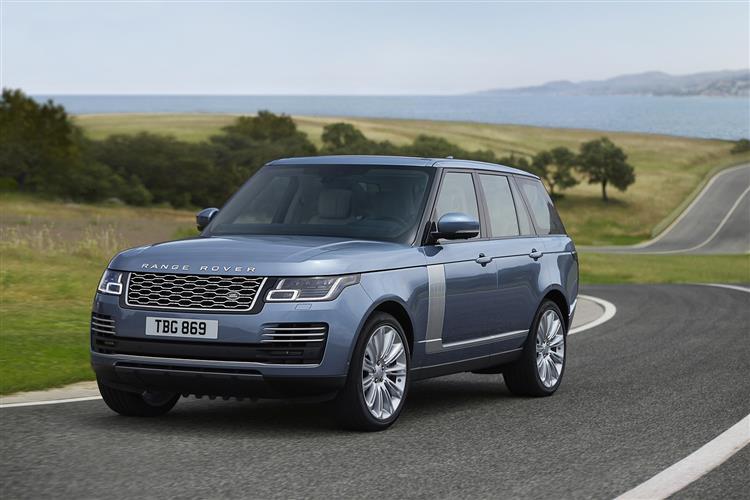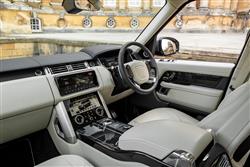HOME ON THE RANGE (some text hidden) --NONE--
By Jonathan Crouch
Introductionword count: 106
So many cars claim to be unique but the Range Rover really is, a car that continued to set the standard in the super-luxury SUV sector in its fourth generation form. Launched in 2012, then substantially improved in 2018 to create the model we're going to look at here, this aluminium-bodied 'L405'-series design offered the option of Plug-in hybrid power and, in all its guises, claimed to be able to properly combine the imperious qualities of a top luxury saloon with off piste abilities that would be limited only by the skills of its driver. A Rolls Royce in the rough, there's nothing quite like it.
Modelsword count: 23
5dr Luxury SUV (2.0 petrol PHEV, 3.0-litre TDV6 diesel, 3.0-litre SDV6 diesel, 4.4-litre SDV8 diesel, 5.0-litre V8 petrol [Vogue, Vogue SE, Autobiography, SVAutobiography])
Historyword count: 458
Sometimes, being the best just isn't good enough. Take the Range Rover. With a pedigree over four distinct generations going all the way back to 1970, it's always been, without question, the 'finest 4x4xfar'. Yet the challenges remain. How to remain the world's leading luxury SUV while appearing credibly eco-centric? How to make further forays into the market for super luxury saloons against rivals that don't have to be able cross the Congo or see you through Siberia? And how to reach out to a whole new group of buyers from both segments who would never previously have considered a Range Rover? This improved fourth generation model was tasked with doing all this - and much more. An extreme challenge certainly - but then this model line is well used to those. Over the decades, we've driven them all over the world, from Icelandic glaciers to the Australian wilderness, from up in the Colorado Rockies to downtown in Beverly Hills. But even we were wondering how on earth the brand might meet the fresh and testing demands of a very different era. This 'L405'-series MK4 model, first launched back in 2012, offered an insight into how the Solihull maker planned to reinterpret the Range Rover formula for a fresh generation of buyers and deal with those challenges. Like the Seventies original, it was clearly revolutionary - and for very much the same reason. A lightweight aluminium body structure set Spencer King's very first Range Rover apart over half a century ago and this plutocratic SUV model's adoption of much the same thing gave this car a credible shot at all its stated goals. The lighter bodyweight meant it could be larger, faster and more responsive at the same time as being more efficient, cheaper to run and better equipped. All of this was important in justifying this car's 'Super-Luxury' SUV status that positioned it a cut above the ordinary large luxury 4x4s that Solihull targeted with its lesser Range Rover Sport. The Range Rover pioneered this rarified segment, but by the 21st century's second decade, it no longer had it to itself, following fresh class arrivals from Bentley, Lamborghini and Mercedes. In response, Land Rover significantly updated this iconic model for the 2018 year with an all-new interior, extra safety and infotainment technology and, perhaps most importantly, the option of a Plug-in petrol/electric powertrain. As a result, this flagship Range Rover model line could claim a lighter eco-footprint, a properly limousine-like rear cabin and performance that, with the right engineering package, could even approach that of a super-saloon. And yes, it'll be even better if you're setting off across the Serengeti or exploring the Amazon. It sold until the arrival of the fifth generation model in late 2021.
What You Getword count: 421
This is every inch a Range Rover. You'd know it as such even without a glance at the elegant badge work. Which is as it should be. Gerry McGovern's design team committed early on to protect the visual characteristics that have always made this car what it is: the wrap-around clamshell bonnet; the deep glass area; the low waist and straight side feature line with no wedge or step up in side styling; the close wheel arch cuts; and the two-piece tailgate. Specific changes made to this model for the 2018 model year mainly centre around the revised front grille (Land Rover had to redesign it to allow for the insertion of the charging port needed for the new PHEV model). The bumper was subtly re-styled too, featuring widened vent blades. You'd be disappointed if you didn't have to climb up into a Range Rover - that's part of its appeal. Seated commandingly up-front amongst the beautiful leathers, polished metal, deep pile carpet and glossy surfacing, you'll find yourself in a cabin that looks as classy and cosseting as you'd want. This post-2018 model featured clean, elegant controls, wider re-designed leather seats and the improved 'Touch Pro Duo' infotainment system we first saw on the Velar, complete with its two high-definition 10-inch central touchscreens. Anything that Panasonic-developed set-up can't tell you will almost certainly be covered off by the digitally customisable 12.3-inch so-called 'Interactive Driver Display' you view through the imposing four-spoke stitched multi-function wheel. And the rear? Well this was an important area for Land Rover to get right in this car, hence the 42mm of extra wheelbase length added into this fourth generation model. Even in the short wheelbase model, it's easy to get comfortable once inside, with (as standard) heated upholstery and a powered reclining backrest for longer journeys. There's over a metre of leg-stretching room - and you can extend that by a further 186mm if you go for the long wheelbase body style. As usual with a Range Rover, there's a classic split tailgate, which is power-operated and gesture-controlled with a wave of your foot beneath the bumper. Once activated, a 909-litre luggage bay is revealed. You'll get a little less if you go for the PHEV variant, but the space available still out-shines what's on offer from many key rivals and is very accessible thanks to buttons which can activate the air suspension to lower the floor height. More buttons electronically flatten the rear seat backs, freeing up as much as 2,360-litres of cargo room.
To see the full road test text contact us on 0330 0020 227
Pictures (high res disabled)

.jpg)
|
.jpg)
|
.jpg)
| |||
.jpg)
|
.jpg)
|
.jpg)
| |||
.jpg)
|
.jpg)
|
.jpg)
| |||

|
Scoring (subset of scores)
Category: Crossover or SUV 4x4s
| Performance | |
| Handling | |
| Comfort | |
| Space | |
| Styling, Build, Value, Equipment, Depreciation, Handling, Insurance and Total scores are available with our full data feed. | |



